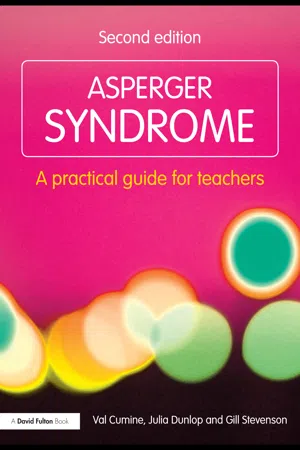
- 116 pages
- English
- ePUB (mobile friendly)
- Available on iOS & Android
About this book
This fully revised new edition is a clear and concise guide to effective classroom practice. It is designed for teachers and assistants supporting children with Asperger syndrome in mainstream schools and other non-specialist settings. The book provides up-to-date information on the latest developments in this area and relates this to educational practice. With examples of innovative strategies and approaches to facilitate progress in learning, this new edition:
- outlines the underlying impairments and their educational implications;
- explores the process of assessment and diagnosis in Asperger Syndrome;
- offers practical strategies for effective and realistic classroom intervention, including access to the National Curriculum;
- considers the behavioural challenges the child with Asperger Syndrome may pose;
- shows how transitions can be supported.
Asperger Syndrome: A Practical Guide for Teachers, 2nd Edition seeks to inform professionals meeting a child with Asperger Syndrome for the first time and equip them with effective educational and behavioural intervention strategies. This new edition is also updated with reference to Every Child Matters, the Disability Equality Duty and Access Inclusion Planning.
This book will be essential to professionals in mainstream schools, educational psychologists, INSET providers (including initial teacher training), as well as to parents, carers and others supporting social and behavioural progress for students with Asperger Syndrome.
Frequently asked questions
- Essential is ideal for learners and professionals who enjoy exploring a wide range of subjects. Access the Essential Library with 800,000+ trusted titles and best-sellers across business, personal growth, and the humanities. Includes unlimited reading time and Standard Read Aloud voice.
- Complete: Perfect for advanced learners and researchers needing full, unrestricted access. Unlock 1.4M+ books across hundreds of subjects, including academic and specialized titles. The Complete Plan also includes advanced features like Premium Read Aloud and Research Assistant.
Please note we cannot support devices running on iOS 13 and Android 7 or earlier. Learn more about using the app.
Information
CHAPTER 1
Asperger syndrome An introduction
Who was Asperger?
Autism and Asperger syndrome







The triad of impairments in autism



Di...
Table of contents
- Contents
- Figures
- About the authors
- Preface
- CHAPTER 1 Asperger syndrome An introduction
- CHAPTER 2 Assessment and diagnosis
- CHAPTER 3 Educational implications of current theories
- CHAPTER 4 A framework for educational intervention
- CHAPTER 5 Educational intervention in practice
- CHAPTER 6 Behavioural intervention
- CHAPTER 7
- Appendix
- References
- Index